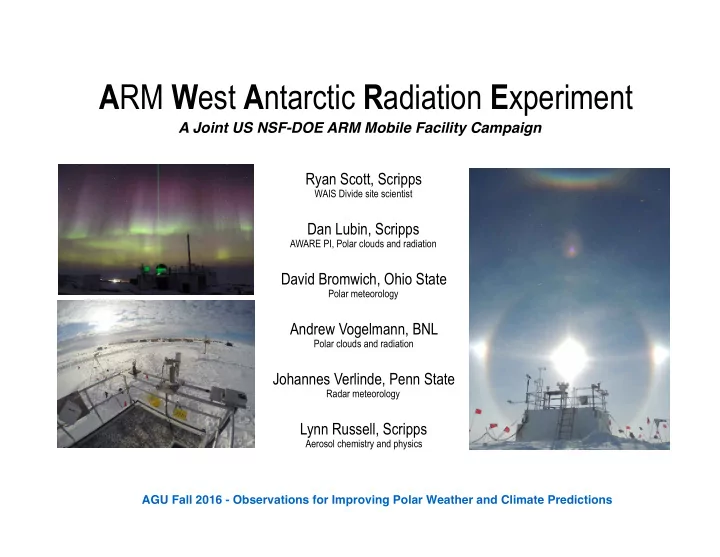

A RM W est A ntarctic R adiation E xperiment A Joint US NSF-DOE ARM Mobile Facility Campaign Ryan Scott, Scripps WAIS Divide site scientist Dan Lubin, Scripps AWARE PI, Polar clouds and radiation David Bromwich, Ohio State Polar meteorology Andrew Vogelmann, BNL Polar clouds and radiation Johannes Verlinde, Penn State Radar meteorology Lynn Russell, Scripps Aerosol chemistry and physics AGU Fall 2016 - Observations for Improving Polar Weather and Climate Predictions
Scientific Motivation for AWARE ( above ) Annual-mean air temperature time series from the Byrd AWS in central West Byrd Antarctica (Bromwich et al. 2013) Trend: 0.42±0.24 o C/decade ( left ) Antarctic ice shelf thickness change from 1994-2012 (Paolo et al. 2015) AGU Fall 2016 - Observations for Improving Polar Weather and Climate Predictions
Scientific Motivation for AWARE Rapid warming of West Antarctica linked to grounded • ice loss and global sea-level rise WAIS mass loss currently driven by warm seawater • Satellite microwave record also reveals sporadic, extensive • surface melt events (e.g., January 2005) No comprehensive atmospheric data since the decade • JANUARY 2005 following the 1957-58 IGY Warming likely driven by advection of warm and moist Southern Ocean air masses • Dynamical mechanisms vary with season, involve complex teleconnections with (sub)tropical SST • Atmospheric forcing projected to become a dominant contributor to WAIS mass loss • (DeConto and Pollard 2016) similar to Greenland (van den Broeke et al. 2016) Surface meltwater known to alter Antarctic Peninsula and Greenland ice dynamics • Need to understand the WAIS surface energy budget and the influence of clouds! • AGU Fall 2016 - Observations for Improving Polar Weather and Climate Predictions
The ARM Program ARM offers the most advanced set of atmospheric instrumentation available for climate research worldwide Each instrument has a mentor Pre- and post-season calibration AWARE Central Facility: McMurdo Station, Ross Island Extended Facility: WAIS Divide Ice Camp AGU Fall 2016 - Observations for Improving Polar Weather and Climate Predictions
Meteorological connection between AWARE sites Ross Island WAIS Divide WAIS Divide Longitude [degrees E] Ross Island Scott et al. 2017, Journal of Climate AGU Fall 2016 - Observations for Improving Polar Weather and Climate Predictions
Deployments well-situated to capture advective warming Nicolas and Bromwich 2014, Journal of Climate AGU Fall 2016 - Observations for Improving Polar Weather and Climate Predictions
WAIS Divide Ice Camp 4 Dec 2015 - 18 Jan 2016 AGU Fall 2016 - Observations for Improving Polar Weather and Climate Predictions
Sky Radiation Suite (SKYRAD) SIO Spectroradiometer Micropulse (Depolarization) Lidar Balloon-Borne Sounding System
Sky Radiation Suite (SKYRAD) SIO Spectroradiometer Incoming longwave radiation 260 broadband irradiance [W m -2 ] 240 220 200 180 160 140 345 346 347 348 349 350 351 352 calendar day of 2015 Micropulse (Depolarization) Lidar Balloon-Borne Sounding System
Sky Radiation Suite (SKYRAD) SIO Spectroradiometer WAIS Divide, Antarctica [W m -2 nm -1 ] 350 1 400 450 500 550 0.9 600 650 700 0.8 750 800 wavelength [nm] 850 900 0.7 950 1000 1050 1100 0.6 1150 1200 1250 0.5 1300 1350 1400 1450 0.4 1500 1550 1600 1650 0.3 1700 1750 1800 0.2 1850 1900 1950 2000 0.1 2050 2100 2150 2200 0 500 1000 1500 2000 2500 3000 3500 4000 spectrum # Micropulse (Depolarization) Lidar Balloon-Borne Sounding System
Sky Radiation Suite (SKYRAD) SIO Spectroradiometer Micropulse (Depolarization) Lidar Balloon-Borne Sounding System
Sky Radiation Suite (SKYRAD) SIO Spectroradiometer Micropulse (Depolarization) Lidar Balloon-Borne Sounding System WAIS Divide MPL depolarization ratio 1 2700 0.9 2400 0.8 2100 0.7 range [m] 1800 0.6 1500 0.5 1200 0.4 900 0.3 600 0.2 300 0.1 0 0 1000 2000 3000 4000 5000 6000 7000 8000 seconds
WAIS Divide, Antarctica JAN 2016 [x100%] 1 2700 2400 range [m] 2100 1800 1500 0.5 1200 900 600 300 0 0 1000 2000 3000 4000 5000 6000 7000 8000 seconds [x10] [W m -2 nm -1 ] 1.6 µ m window 0.1 0.05 0 200 400 600 800 1000 1200 1400 spectrum # 1.6 µ m flux [W m -2 ] 25 20 15 10 5 200 400 600 800 1000 1200 1400 spectrum # × 10 -5 slope 1534-1593 nm 5 0 -5 -10 -15 200 400 600 800 1000 1200 1400 spectrum #
AMF2 on Ross Island November 2015 - December 2016 AGU Fall 2016 - Observations for Improving Polar Weather and Climate Predictions
AGU Fall 2016 - Observations for Improving Polar Weather and Climate Predictions
AGU Fall 2016 - Observations for Improving Polar Weather and Climate Predictions
AWARE data are YOUR data! ARM data archive: www.arm.gov Free and open access worldwide More information + time-lapses + photos at: scripps.ucsd.edu/expeditions/aware
Recommend
More recommend